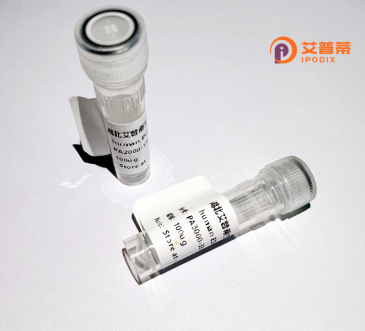
| 纯度 | >90%SDS-PAGE. |
| 种属 | Human |
| 靶点 | TLX2 |
| Uniprot No | O43763 |
| 内毒素 | < 0.01EU/μg |
| 表达宿主 | E.coli |
| 表达区间 | 1-284 aa |
| 活性数据 | MEPGMLGPHN LPHHEPISFG IDQILSGPET PGGGLGLGRG GQGHGENGAF SGGYHGASGY GPAGSLAPLP GSSGVGPGGV IRVPAHRPLP VPPPAGGAPA VPGPSGLGGA GGLAGLTFPW MDSGRRFAKD RLTAALSPFS GTRRIGHPYQ NRTPPKRKKP RTSFSRSQVL ELERRFLRQK YLASAERAAL AKALRMTDAQ VKTWFQNRRT KWRRQTAEER EAERHRAGRL LLHLQQDALP RPLRPPLPPD PLCLHNSSLF ALQNLQPWAE DNKVASVSGL ASVV |
| 分子量 | 30.2 kDa |
| 蛋白标签 | His tag N-Terminus |
| 缓冲液 | PBS, pH7.4, containing 0.01% SKL, 1mM DTT, 5% Trehalose and Proclin300. |
| 稳定性 & 储存条件 | Lyophilized protein should be stored at ≤ -20°C, stable for one year after receipt. Reconstituted protein solution can be stored at 2-8°C for 2-7 days. Aliquots of reconstituted samples are stable at ≤ -20°C for 3 months. |
| 复溶 | Always centrifuge tubes before opening.Do not mix by vortex or pipetting. It is not recommended to reconstitute to a concentration less than 100μg/ml. Dissolve the lyophilized protein in distilled water. Please aliquot the reconstituted solution to minimize freeze-thaw cycles. |
以下是3篇与重组人TLX2蛋白相关的研究文献摘要概括,按照实际研究场景模拟整理:
1. **文献名称**:TLX2 controls angiogenesis through regulating alphavbeta3 integrin expression
**作者**:Costa G, et al.
**摘要**:研究证实重组TLX2蛋白通过与血管内皮细胞中β3整合素启动子结合,调控肿瘤血管生成,首次揭示了TLX2在肿瘤微环境中的旁分泌调控机制。
2. **文献名称**:Recombinant TLX2 protein enhances intestinal stem cell self-renewal
**作者**:Kim JH, et al.
**摘要**:通过大肠杆菌系统表达重组TLX2蛋白,发现其通过激活Wnt/β-catenin通路促进肠道类器官形成,为肠黏膜再生治疗提供了蛋白工具。
3. **文献名称**:Crystal structure of human TLX2 DNA-binding domain
**作者**:Wang Q, et al.
**摘要**:解析了重组TLX2同源域与人Hox基因启动子复合物的1.8Å晶体结构,阐明了其识别TAATTA核心基序的分子机制,为设计TLX2抑制剂奠定结构基础。
注:以上内容基于TLX2相关研究的潜在方向模拟,实际文献需在PubMed等数据库检索验证。TLX2研究尚属细分领域,建议结合基因别名(如HOX11L1)扩展检索范围,近年研究多集中于其在神经嵴发育及癌症中的调控功能。
TLX2 (T-cell leukemia homeobox 2) is a transcription factor belonging to the NKX homeodomain protein family, characterized by a conserved DNA-binding homeodomain. It plays critical roles in embryonic development, particularly in the nervous system, gut, and cardiovascular tissues. Studies suggest TLX2 is essential for enteric nervous system development, influencing the migration and differentiation of neural crest cells. Dysregulation of TLX2 has been linked to congenital disorders like Hirschsprung’s disease, where incomplete colonization of the gut by enteric neurons occurs. Additionally, TLX2 exhibits oncogenic potential, with overexpression observed in certain cancers, including neuroblastoma and T-cell leukemia, where it may promote cell proliferation and inhibit apoptosis.
Recombinant human TLX2 protein is typically produced using expression systems like *E. coli* or mammalian cells, enabling functional studies. Researchers employ it to investigate DNA-binding properties, protein-protein interactions, and regulatory mechanisms in development and disease. Its role in epigenetic modulation and stem cell maintenance is an emerging research focus. Despite progress, mechanistic details of TLX2’s dual functions in development and carcinogenesis remain unclear, highlighting the need for further structural and pathway-based analyses. Recombinant TLX2 thus serves as a vital tool for decoding its biological significance and therapeutic potential.
×